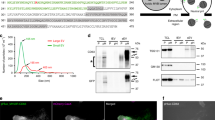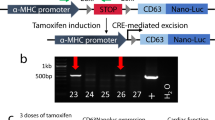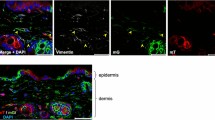Abstract
Extracellular vesicle (EV) transfer is increasingly recognized as an important mode of intercellular communication by transferring a wide variety of biomolecules between cells. The characterization of in vitro– or ex vivo–isolated EVs has considerably contributed to the understanding of biological functions of EV transfer. However, the study of EV release and uptake in an in vivo setting has remained challenging, because cells that take up EVs could not be discriminated from cells that do not take up EVs. Recently, a technique based on the Cre-loxP system was developed to fluorescently mark Cre-reporter cells that take up EVs released by Cre recombinase–expressing cells in various in vitro and in vivo settings. Here we describe a detailed protocol for the generation of Cre+ cells and reporter+ cells, which takes ∼6 weeks, and subsequent assays with these lines to study functional EV transfer in in vitro and in vivo (mouse) settings, which take up to ∼2 months.
This is a preview of subscription content, access via your institution
Access options
Subscribe to this journal
Receive 12 print issues and online access
$259.00 per year
only $21.58 per issue
Buy this article
- Purchase on Springer Link
- Instant access to full article PDF
Prices may be subject to local taxes which are calculated during checkout




Similar content being viewed by others

References
Ratajczak, J. et al. Embryonic stem cell-derived microvesicles reprogram hematopoietic progenitors: evidence for horizontal transfer of mRNA and protein delivery. Leukemia 20, 847–856 (2006).
Valadi, H. et al. Exosome-mediated transfer of mRNAs and microRNAs is a novel mechanism of genetic exchange between cells. Nat. Cell Biol. 9, 654–659 (2007).
Pegtel, D.M. et al. Functional delivery of viral miRNAs via exosomes. Proc. Natl. Acad. Sci. USA 107, 6328–6333 (2010).
Hood, J.L., San, R.S. & Wickline, S.A. Exosomes released by melanoma cells prepare sentinel lymph nodes for tumor metastasis. Cancer Res. 71, 3792–3801 (2011).
Costa-Silva, B. et al. Pancreatic cancer exosomes initiate pre-metastatic niche formation in the liver. Nat. Cell Biol. 17, 816–826 (2015).
Peinado, H. et al. Melanoma exosomes educate bone marrow progenitor cells toward a pro-metastatic phenotype through MET. Nat. Med. 18, 883–891 (2012).
Cai, Z. et al. Activated T cell exosomes promote tumor invasion via Fas signaling pathway. J. Immunol. 188, 5954–5961 (2012).
Luga, V. et al. Exosomes mediate stromal mobilization of autocrine Wnt-PCP signaling in breast cancer cell migration. Cell 151, 1542–1556 (2012).
Salomon, C. et al. Hypoxia-induced changes in the bioactivity of cytotrophoblast-derived exosomes. PLoS ONE 8, e79636 (2013).
Boelens, M.C. et al. Exosome transfer from stromal to breast cancer cells regulates therapy resistance pathways. Cell 159, 499–513 (2014).
Melo, S.A. et al. Cancer exosomes perform cell-independent microRNA biogenesis and promote tumorigenesis. Cancer Cell 26, 707–721 (2014).
Zomer, A. et al. In vivo imaging reveals extracellular vesicle-mediated phenocopying of metastatic behavior. Cell 161, 1046–1057 (2015).
Raposo, G. & Stoorvogel, W. Extracellular vesicles: exosomes, microvesicles, and friends. J. Cell Biol. 200, 373–383 (2013).
Thery, C. Exosomes: secreted vesicles and intercellular communications. F1000 Biol. Rep. 3, 15 (2011).
Colombo, M., Raposo, G. & Thery, C. Biogenesis, secretion, and intercellular interactions of exosomes and other extracellular vesicles. Annu. Rev. Cell Dev. Biol. 30, 255–289 (2014).
Minciacchi, V.R., Freeman, M.R. & Di Vizio, D. Extracellular vesicles in cancer: exosomes, microvesicles and the emerging role of large oncosomes. Semin. Cell Dev. Biol. 40, 41–51 (2015).
Sverdlov, E.D. Amedeo Avogadro’s cry: what is 1 μg of exosomes? Bioessays 34, 873–875 (2012).
Ridder, K. et al. Extracellular vesicle-mediated transfer of genetic information between the hematopoietic system and the brain in response to inflammation. PLoS Biol. 12, e1001874 (2014).
Ridder, K. et al. Extracellular vesicle-mediated transfer of functional RNA in the tumor microenvironment. Oncoimmunology 4, e1008371 (2015).
Thery, C., Amigorena, S., Raposo, G. & Clayton, A. Isolation and characterization of exosomes from cell culture supernatants and biological fluids. Curr. Protoc. Cell Biol. Chapter 3 Unit 3.22 (2006).
van der Pol, E., Boing, A.N., Harrison, P., Sturk, A. & Nieuwland, R. Classification, functions, and clinical relevance of extracellular vesicles. Pharmacol. Rev. 64, 676–705 (2012).
Bard, M.P. et al. Proteomic analysis of exosomes isolated from human malignant pleural effusions. Am. J. Respir. Cell Mol. Biol. 31, 114–121 (2004).
Gyorgy, B. et al. Detection and isolation of cell-derived microparticles are compromised by protein complexes resulting from shared biophysical parameters. Blood 117, e39–e48 (2011).
Rood, I.M. et al. Comparison of three methods for isolation of urinary microvesicles to identify biomarkers of nephrotic syndrome. Kidney Int. 78, 810–816 (2010).
Gyorgy, B. et al. Membrane vesicles, current state-of-the-art: emerging role of extracellular vesicles. Cell. Mol. Life Sci. 68, 2667–2688 (2011).
Lotvall, J. et al. Minimal experimental requirements for definition of extracellular vesicles and their functions: a position statement from the International Society for Extracellular Vesicles. J. Extracell. Vesicles 3, 26913 (2014).
Christianson, H.C., Svensson, K.J., van Kuppevelt, T.H., Li, J.P. & Belting, M. Cancer cell exosomes depend on cell-surface heparan sulfate proteoglycans for their internalization and functional activity. Proc. Natl. Acad. Sci. USA 110, 17380–17385 (2013).
Svensson, K.J. et al. Exosome uptake depends on ERK1/2-heat shock protein 27 signaling and lipid raft-mediated endocytosis negatively regulated by caveolin-1. J. Biol. Chem. 288, 17713–17724 (2013).
Lai, C.P. et al. Visualization and tracking of tumour extracellular vesicle delivery and RNA translation using multiplexed reporters. Nat. Commun. 6, 7029 (2015).
Hoshino, D. et al. Exosome secretion is enhanced by invadopodia and drives invasive behavior. Cell Rep. 5, 1159–1168 (2013).
Suetsugu, A. et al. Imaging exosome transfer from breast cancer cells to stroma at metastatic sites in orthotopic nude-mouse models. Adv. Drug Deliv. Rev. 65, 383–390 (2013).
Sung, B.H., Ketova, T., Hoshino, D., Zijlstra, A. & Weaver, A.M. Directional cell movement through tissues is controlled by exosome secretion. Nat. Commun. 6, 7164 (2015).
Bobrie, A. et al. Rab27a supports exosome-dependent and -independent mechanisms that modify the tumor microenvironment and can promote tumor progression. Cancer Res. 72, 4920–4930 (2012).
Mulcahy, L.A., Pink, R.C. & Carter, D.R. Routes and mechanisms of extracellular vesicle uptake. J. Extracell. Vesicles 3, 10.3402/jev.v3.24641 (2014).
Vojtech, L. et al. Exosomes in human semen carry a distinctive repertoire of small non-coding RNAs with potential regulatory functions. Nucleic Acids Res. 42, 7290–7304 (2014).
Zomer, A. et al. Exosomes: fit to deliver small RNA. Commun. Integr. Biol. 3, 447–450 (2010).
Bolukbasi, M.F. et al. miR-1289 and 'zipcode'-like sequence enrich mRNAs in microvesicles. Mol. Ther. Nucleic Acids 1, e10 (2012).
Nordin, J.Z. et al. Ultrafiltration with size-exclusion liquid chromatography for high yield isolation of extracellular vesicles preserving intact biophysical and functional properties. Nanomedicine 11, 879–883 (2015).
Madisen, L. et al. A robust and high-throughput Cre reporting and characterization system for the whole mouse brain. Nat. Neurosci. 13, 133–140 (2010).
Acknowledgements
We thank A. de Graaff and the Hubrecht Imaging Centre for imaging support. We thank A. Kamermans for experimental and imaging assistance and W. Karthaus for his help with cloning the pLV-CMV-LoxP-DsRed-LoxP-eGFP construct. We thank J. Segall (Albert Einstein College of Medicine, New York) for providing us with MDA-MB-231 cells. This work was supported by a Vidi fellowship (no. 91710330); research grants from the Dutch Organization of Scientific Research (NWO; no. 823.02.017), the Dutch Cancer Society (KWF; HUBR 2009-4621) and Cancer Genomics Netherlands (all to J.v.R.); and equipment grants (nos. 175.010.2007.00 and 834.11.002) from the Dutch Organization of Scientific Research (NWO).
Author information
Authors and Affiliations
Contributions
A.Z. and S.C.S. wrote the manuscript, prepared the figures and optimized the described procedures and the data presented. C.M. optimized the Transwell experiments and helped to write the manuscript. J.v.R. conceived and supervised the study, and helped to write the manuscript.
Corresponding author
Ethics declarations
Competing interests
The authors declare no competing financial interests.
Integrated supplementary information
Supplementary Figure 1 Visualizing uptake of in vitro-purified Cre+ EVs
EVs isolated from Cre+ C26 colorectal carcinoma cells were isolated using differential centrifugation as described in the Supplementary Methods. Different amounts of these EVs were added to C26 reporter+ cells and after 72 h incubation, eGFP+ cells were scored by fluorescence microscopy (n = 1).
Supplementary information
Supplementary Text and Figures
Supplementary Figure 1 and Supplementary Methods (PDF 304 kb)
Rights and permissions
About this article
Cite this article
Zomer, A., Steenbeek, S., Maynard, C. et al. Studying extracellular vesicle transfer by a Cre-loxP method. Nat Protoc 11, 87–101 (2016). https://doi.org/10.1038/nprot.2015.138
Published:
Issue Date:
DOI: https://doi.org/10.1038/nprot.2015.138
This article is cited by
-
A new transgene mouse model using an extravesicular EGFP tag enables affinity isolation of cell-specific extracellular vesicles
Scientific Reports (2022)
-
GOLM1 exacerbates CD8+ T cell suppression in hepatocellular carcinoma by promoting exosomal PD-L1 transport into tumor-associated macrophages
Signal Transduction and Targeted Therapy (2021)
-
Spatial and temporal tracking of cardiac exosomes in mouse using a nano-luciferase-CD63 fusion protein
Communications Biology (2020)
-
A CRISPR-Cas9-based reporter system for single-cell detection of extracellular vesicle-mediated functional transfer of RNA
Nature Communications (2020)
-
Exosomal Secretion of Adipose Tissue during Various Physiological States
Pharmaceutical Research (2020)
Comments
By submitting a comment you agree to abide by our Terms and Community Guidelines. If you find something abusive or that does not comply with our terms or guidelines please flag it as inappropriate.


